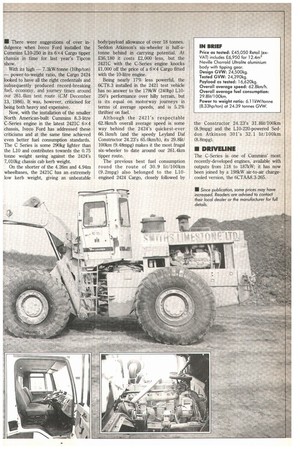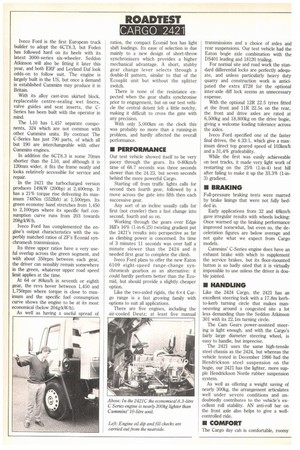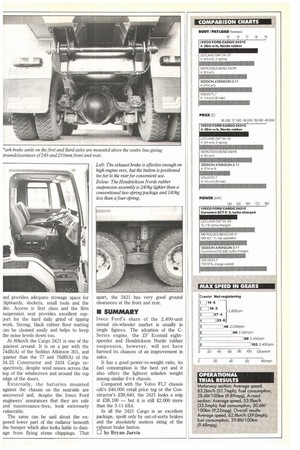CARGO WITH A CAPITAL C
Page 26

Page 27

Page 28

Page 29

If you've noticed an error in this article please click here to report it so we can fix it.
Helped by the new C Series engine, lveco Ford's 2421 Cargo tipper is 750kg lighter than the 2424 and is the most frugal tipper yet tested round our test route.
• There were suggestions of over indulgence when Iveco Ford installed the Cummins L10-250 in its 6x4 Cargo tipper chassis in time for last year's Tipcon show.
With its high — 7.3kW/tonne (10hp/ton) — power-to-weight ratio, the Cargo 2424 looked to have all the right credentials and subsequently produced record-breaking fuel, economy, and journey times around our 261.4km test route (CM December 13, 1986). It was, however, criticised for being both heavy and expensive.
Now, with the installation of the smaller North American-built Cummins 8.3-litre C-Series engine in the latest 2421C 6>4 chassis, Iveco Ford has addressed these criticisms and at the same time achieved even better fuel consumption standards. The C Series is some 290kg lighter than the L10 and contributes towards the 0.75 tonne weight saving against the 2424's 7,010kg chassis cab kerb weight.
On the shorter of the 4.26m and 4.94m wheelbases, the 2421C has an. extremely low kerb weight, giving an unbeatable body/payload allowance of over 18 tonnes. Seddon Atkinson's six-wheeler is half-atonne behind in carrying potential. At £36,180 it costs £2,000 less, but the 2421C with the C-Series engine knocks £1,000 off the price of a 6x4 Cargo fitted with the 10-litre engine.
Being nearly 17% less powerful, the 6CT8.3 installed in the 2421 test vehicle has no answer to the 179kW (240hp) L10250's performance over hilly terrain, but is its equal on motorway journeys in terms of average speeds, and is 5.2% thriftier on fuel.
Although the 2421's respectable 62.81Ern/h overall average speed is some way behind the 2424's quickest-ever 66.1km/h (and the speedy Leyland Dal Constructor 24.23's 65.0krn/h), its 29.8lit/ 100km (9.48mpg) makes it the most frugal six-wheeler to date around our 261.41un tipper route.
The previous best fuel consumption round the route of 30.9 lit/100km (9.2mpg) also belonged to the L10engined 2424 Cargo, closely followed by the Constructor 24.23's 31.81it/100km (8.9rnpg) and the L10-220-powered Seddon Atkinson 301's 32.1 lit/100km (8. 8mpg).
• DRIVELINE
The C-Series is one of Cummins' most recently-developed engines, available with outputs from 118 to 187kW; it has now been joined by a 198kW air-to-air chargecooled version, the 6CTAA8.3-265.
Iveco Ford is the first European truck builder to adopt the 6CT8.3, but Foden has followed hard on its heels with its latest 3000-series six-wheeler. Seddon Atkinson will also be fitting it later this year, and both ERF and Leyland Daf look odds-on to follow suit The engine is largely built in the US, but once a demand is established Cummins may produce it in Britain.
With its alloy cast-iron skirted block, replaceable centre-sealing wet liners, valve guides and seat inserts, the CSeries has been built with the operator in mind.
The L10 has 1,457 separate components, 324 which are not common with other Cummins units. By contrast The C-Series has just 790 parts, of which all but 190 are interchangeable with other Cummins engines.
In addition the 6CT8.3 is some 70mm shorter than the L10, and although it is 120mm wider, it fits the frame neatly and looks relatively accessible for service and repair.
In the 2421 the turbocharged version produces 149kW (200hp) at 2,400rmp. It has a 21% torque rise delivering its maximum 748Nm (552Ibft) at 1,500rpm. Its green economy band stretches from 1,450 to 2,100rpm where its specific fuel consumption curve runs from 203 towards 208g/kW/h.
Iveco Ford has complemented the engine's output characteristics with the superbly matched ratios of ZF's Ecomid synchromesh transmission.
Its three upper ratios have a very useful overlap across the green segment, and with about 350rpm between each gear, the driver can sensibly remain somewhere in the green, whatever upper road speed limit applies at the time.
At 64 or 80km/h in seventh or eighth gear, the revs hover between 1,450 and 1,750rpm where torque is close to maximum and the specific fuel consumption curve shows the engine to be at its most economical (below 204g/kW/h).
As well as having a useful spread of ratios, the compact Ecomid box has light shift loadings. Its ease of selection is due mainly to a new design of short-throw synchronisers which provides a higher mechanical advantage. A short, stubby gear change lever selects through a double-H pattern, similar to that of the Ecosplit unit but without the splitter switch.
There is none of the resistance expected when the gear shafts synchronise prior to engagement, but on our test vehicle the central detent felt a little notchy, making it difficult to cross the gate with any precision.
With only 5,000krn on the clock this was probably no more than a running-in problem, and hardly affected the overall performance.
• PERFORMANCE
Our test vehicle showed itself to be very pacey through the gears. Its 0-80km/h time of 68.7 seconds was three seconds slower than the 24.23, but seven seconds behind the more powerful Cargo.
Starting off from traffic lights calls for second then fourth gear, followed by a move across the gate into fifth then each successive gear.
Any sort of an incline usually calls for first (not crawler) then a fast change into second, fourth and so on.
Working through the gears over Edge Hill's 16% (1-in-6.25) twisting gradient put the 2421's results into perspective as far as climbing power is concerned. Its time of 3 minutes 11 seconds was over half a minute slower than the 2424 and it needed first gear to complete the climb.
Iveco Ford plans to offer the new Eaton 6109 eight-speed range-change synchromesh gearbox as an alternative: it could hardly perform better than the Ecomid, but should provide a slightly cheaper option.
Like the two-axled rigids, the 6x4 Cargo range is a fast growing family with options to suit all applications.
There are five engines, including the air-cooled Deutz; at least five manua transmissions and a choice of axles and rear suspensions. Our test vehicle had the Eaton bogie axle combination with the DS401 leading and 18120 trailing.
For normal site and road work the standard differential locks are perfectly adequate, and unless particularly heavy duty quarry and construction work is anticipated the extra 2728 for the optional inter-axle diff lock seems an unnecessary expense.
With the optional 12R 22.5 tyres fitted at the front and 11R 22.5s on the rear, the front and drive axles are rated at 6,500kg and 18,800kg on the drive bogie, giving a welcome loading tolerance across the axles.
Iveco Ford specified one of the faster final drives, the 4.33:1, which give a maximum direct top geared speed of 103km/h and a 31,4% gradeability.
While the first was easily achieveable on test tracks, it made very light work of restarting on the 25% (1-in-4) test hill after failing to make it up the 33.3% (1-in3) gradient.
• BRAKING
Full-pressure braking tests were marred by brake linings that were not fully beddeil in.
Early applications from 32 and 481cm/h gave irregular results with wheels locking: Once warmed up the braking performance improved somewhat, but even so, the deceleration figures are below average and not quite what we expect from Cargo models.
Cummins' C-Series engine does have an exhaust brake with which to supplement the service brakes, but its floor-mounted button is so badly sited that it is virtually impossible to use unless the driver is double jointed.
• HANDLING
Like the 2424 Cargo, the 2421 has an excellent steering lock with a 17.8m kerbto-kerb turning circle that makes manoeuvring around a congested site a lot less demanding than the Seddon Atkinson 301 with its 22.1m turning circle.
The Cam Gears power-assisted steering is light enough, and with the Cargo's fairly large diameter steering wheel, is easy to handle, but imprecise.
The 2421 uses the same high-tensile steel chassis as the 2424, but whereas the vehicle tested in December 1986 had the Hendrickson steel suspension on the bogie, our 2421 has the lighter, more supple Hendrickson Norde rubber suspension system.
As well as offering a weight saving of nearly 300kg, the arrangement articulates well under severe conditions and undoubtedly contributes to the vehicle's excellent roll stability. AN anti-roll bar on the front axle also helps to give a wellcontrolled ride.
• COMFORT
The Cargo day cab is comfortable, roomy and provides adequate stowage space for clipboards, dockets, small tools and the Like. Access is first class and the firm suspension seat provides excellent support for the hard daily grind of tipping work. Strong, black rubber floor matting can be cleaned easily and helps to keep the noise levels down too.
At 80krnih the Cargo 2421 is one of the quietest around. It is on a par with the 74dB(A) of the Seddon Atkinson 301, and quieter than the 77 and 76dB(A) of the 24.23 Constructor and 2424 Cargo respectively, despite wind noises across the top of the windscreen and around the top edge of the doors.
Externally, the batteries mounted against the chassis on the nearside are uncovered and, despite the Iveco Ford engineers' assurances that they are safe and maintenance-free, look extremely vulnerable.
The same can be said about the exposed lower part of the radiator beneath the bumper which also looks liable to damage from flying stone chippings. That apart, the 2421 has very good ground clearances at the front and rear.
• SUMMARY
Iveco Ford's share of the 2,400-unit annual six-wheeler market is usually in single figures. The adoption of the CSeries engine, the ZF Ecomid eightspeeder and Hendrickson Norde rubber suspension, however, will not have harmed its chances of an improvement in sales.
It has a good power-to-weight ratio, its fuel consumption is the best yet and it also offers the lightest unladen weight among similar 6x4 chassis.
Compared with the Volvo FL7 chassis cab's 240,000 retail price tag or the Constructor's 239,640, the 2421 looks a snip at 238,100 — but it is still £2,000 more than the 3-11 6X4.
In all the 2421 Cargo is an excellent package, spoilt only by out-of-sorts brakes and the absolutely useless siting of the exhaust brake button.
0 by Bryan Jarvis


















































































